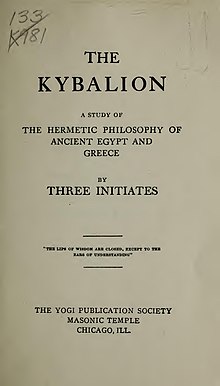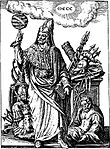|
The Kybalion
The Kybalion (full title: The Kybalion: A Study of the Hermetic Philosophy of Ancient Egypt and Greece) is a book originally published in 1908 by "Three Initiates" (often identified as the New Thought pioneer William Walker Atkinson, 1862–1932)[1] that purports to convey the teachings of Hermes Trismegistus. While it shares with ancient and medieval Hermetic texts a number of traits such as philosophical mentalism, the concept of 'as above, so below', and the idea that everything consists of gendered polar opposites, as a whole it is more indebted to the ideas of modern occultist authors, especially those of the New Thought movement to which Atkinson belonged.[2] A modern Hermetic tract, it has been widely influential in New Age circles since the twentieth century.[3] Seven Hermetic principles
A central concept in the book is that there are "seven Hermetic principles, upon which the entire Hermetic philosophy is based".[4] These are, as literally quoted from the book: 1. The principle of mentalism
2. The principle of correspondence
3. The principle of vibration
4. The principle of polarity
5. The principle of rhythm
6. The principle of cause and effect
7. The principle of gender
Relation to ancient and medieval HermeticaAccording to occult writer Mitch Horowitz, the philosophical mentalism (the primacy of mind as the active cause of things) described by the Kybalion's first principle was inspired by broadly similar notions in the ancient Greek Hermetica.[12] Nicholas E. Chapel notes that while several aspects such as the philosophical mentalism, the concept of "as above, so below" as derived from the Emerald Tablet, and the idea that everything exists as pairs of gendered polar opposites, do have a background in ancient and medieval Hermetic texts, other aspects such as the principle of vibration (which originates in the philosophy of David Hartley, 1705–1757) are not related to Hermeticism.[2] Chapel also points out that there are a number of stark contrasts between the Kybalion and the traditional Hermetica, such as the Kybalion's anti-theological stance versus the heavy emphasis on theology in the Hermetica, or the Kybalion's focus on the practitioner's "mental transmutation" versus the traditional Hermetica's preoccupation with reverence for and unification with the divine. Chapel concludes that as a whole, the Kybalion is too bound up with early 20th-century ideas emanating from the New Thought movement to be representative of the broader historical tradition of Hermetic philosophy.[2] References
Works cited
External links
|
|||||||||||||||||||||||

